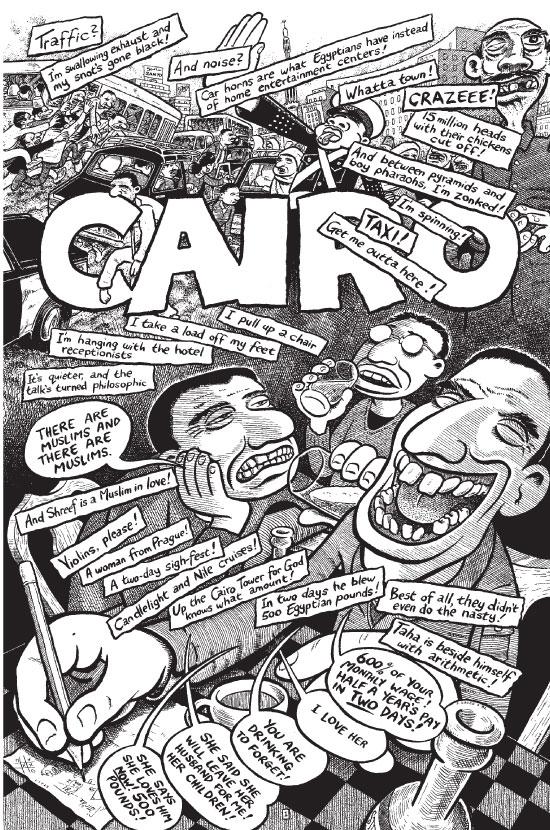The 1990s “indie” comics scene saw two trends. One reflected an almost neurotic drive to get away from the power fantasies of superhero stories. Using a careless graphic style that emphasized the pathologically normal, authors told stories from the point of view of a “defeatist,” in the words of comics artist Joe Sacco.
On the other hand, this was the era in which American non-superhero comics also started engaging with topics bigger than the middle-class suburbs of their creators. Inspiration came from the sudden acceptance of comics in the wake of Art Spiegelman's 1992 Pulitzer Prize for Maus, which also built a bridge between the artistic language of the European bande dessinée and its comparatively low-brow American cousin.
Bringing these two trends together, the first issue of Joe Sacco's Palestine came out in 1993, followed by nine original single comic book issues. Trained as a journalist, Sacco tells the story of the two months he spent in the West Bank and the Gaza Strip between 1991 and 1992.

Palestine’s visual style descends directly from R. Crumb-style 1960s and ’70s “comix.” Black and white drawings make deliberate use of cartooning techniques, such as the amplification of body parts (noses, ears), adding up to punk-inspired visual noise.
But despite initially sharing the same target audience (and the same publisher) as earlier comix, Sacco’s work differed greatly in what it attempted to do. Sacco consciously tackled the complicated relationship between West and East, subjectivity and neutrality, journalism and fiction. The set eventually appeared as a complete story in a single volume, with an introduction by Palestinian-American literary theorist Edward Said.
Palestine's success was followed by a six-page story on the Bosnian war crimes trials in the Netherlands, commissioned by Art Spiegelman for Details magazine. Then came publication of Safe Area Gorazde, the War In Eastern Bosnia 1992-1995.
In Safe Area’s 240 pages, Sacco applies the same techniques he used for Palestine to explore the conflict in a small, Muslim UN-protected enclave in the midst of the Bosnian conflict. His personal voice asserts itself, presenting events from Sacco’s point of view but also allowing other characters to speak directly. There is no intention to achieve “neutrality” or “objectivity.” Both Palestine and Safe Area narrate from the border between documentary and personal travelogue.
Like Safe Area, the first issue of Marjane Satrapi's Persepolis arrived in 2000. Satrapi’s complete narrative, published in France, is also a compilation of instalments published over time. Both feature strong narrative voices, with protagonists representing the actual authors.
Unlike Persepolis, however, Sacco's works are not primarily autobiographical. Though Sacco tells us about specific moments from his life, and makes no attempt to hide the subjectivity filtering the narrated events, the focus of his stories is not himself, but the people and circumstances of the places he visits.
Persepolis and Maus are personal stories narrating very specific moments in human history—the Shoah and the Iranian Revolution. But in spite of all the political and narrative relevance of the historic events in both books, their main genre is that of memoir. Most of the events happened in the past, sometimes before the authors were born, or happened with them being central to the event.
Sacco's work, notwithstanding all the delay between lived experience and the final act of graphic narration, recounts situations he witnessed in real time and as an observer whose mission was to depict those events in comics form, bringing comics one step closer to the techniques of literary reportage.
[Part 3, continuing the shift from survivors’ tales to tales of survival, will appear next week.]
 The 1990s “indie” comics scene saw two trends. One reflected an almost neurotic drive to get away from the power fantasies of superhero stories. Using a careless graphic style that emphasized the pathologically normal, authors told stories from the point of view of a “defeatist,” in the words of comics artist Joe Sacco.
On the other hand, this was the era in which American non-superhero comics also started engaging with topics bigger than the middle-class suburbs of their creators. Inspiration came from the sudden acceptance of comics in the wake of Art Spiegelman's 1992 Pulitzer Prize for Maus, which also built a bridge between the artistic language of the European bande dessinée and its comparatively low-brow American cousin.
Bringing these two trends together, the first issue of Joe Sacco's Palestine came out in 1993, followed by nine original single comic book issues. Trained as a journalist, Sacco tells the story of the two months he spent in the West Bank and the Gaza Strip between 1991 and 1992.
The 1990s “indie” comics scene saw two trends. One reflected an almost neurotic drive to get away from the power fantasies of superhero stories. Using a careless graphic style that emphasized the pathologically normal, authors told stories from the point of view of a “defeatist,” in the words of comics artist Joe Sacco.
On the other hand, this was the era in which American non-superhero comics also started engaging with topics bigger than the middle-class suburbs of their creators. Inspiration came from the sudden acceptance of comics in the wake of Art Spiegelman's 1992 Pulitzer Prize for Maus, which also built a bridge between the artistic language of the European bande dessinée and its comparatively low-brow American cousin.
Bringing these two trends together, the first issue of Joe Sacco's Palestine came out in 1993, followed by nine original single comic book issues. Trained as a journalist, Sacco tells the story of the two months he spent in the West Bank and the Gaza Strip between 1991 and 1992.


